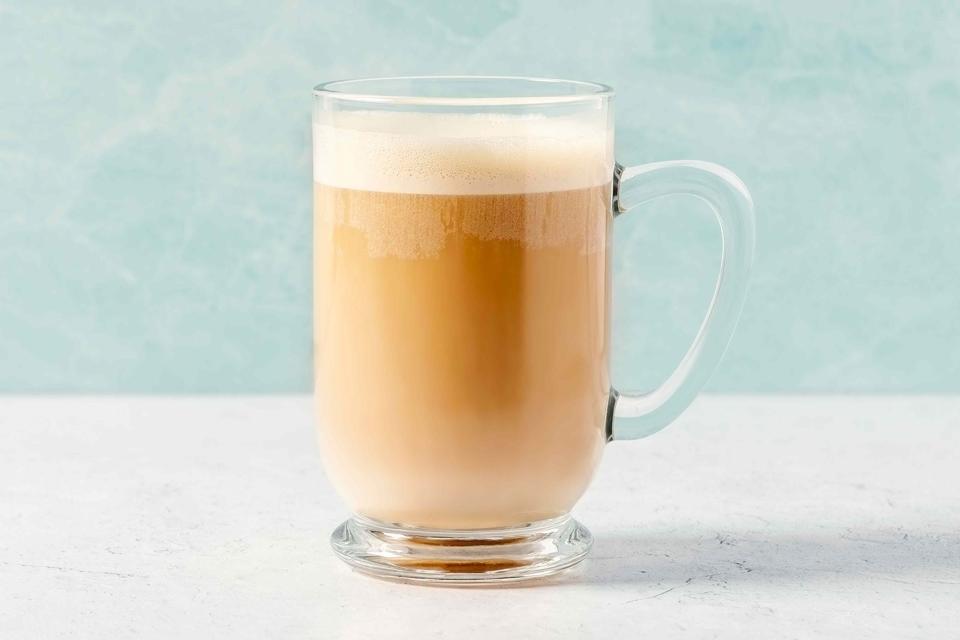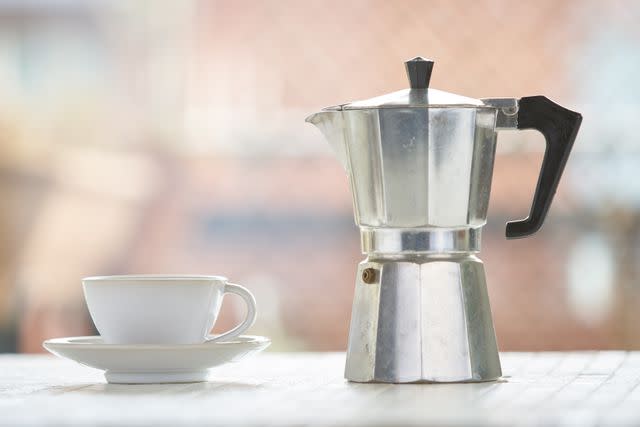How to Make a Latte Without an Espresso Machine, According to Coffee Pros
There are several stand-in methods for concocting this milky java favorite.

Claudia Totir / Getty Images
If you've ever pondered how to make a latte at home without a fancy (and pricey) La Marzocco machine, only to throw up your hands in despair, we're about to turn your coffee habit upside down. While that espresso machine is worth its weight in gold, you may not own one or even have the counter space to house it. Or perhaps you're traveling, far from the caffeine comforts of home. Whatever the circumstances, surprise! You can still concoct coffee shop-style java drinks, including a latte, without that prized small appliance. We reached out to coffee professionals for firsthand advice and picked up some tricks of the trade that are sure to brighten your morning.
Meet Our Expert
Matt Falber, founder of City Boy Coffee, a New York City-based coffee roaster
Kat McCarthy, Specialty Coffee Association Authorized Specialty Coffee Trainer (SCA AST) and New York training manager at Lavazza
Related: 9 Coffee Brewing Mistakes You're Probably Making
What is a Latte?
"The latte you'd get in a good coffee shop is usually made with a ratio of 2 ounces of espresso to 8–10 ounces of hot milk, with a light layer of foam on top," sayss Kat McCarthy, (SCA AST), professional level barista and New York training manager at Lavazza. Those two ingredients, espresso, and hot milk, comprise a latte. "Espresso is more concentrated than coffee, and normally brewed under pressure. The pressure gives it a foamy top called crema," adds Matt Falber, founder of City Boy Coffee, a Long Island City, N.Y.-based roaster offering ethically sourced specialty coffees.
Latte vs. Cappuccino
An American creation, the latte traditionally has less foam than the Italian classic, the cappuccino. "Lattes and cappuccinos are confusing, even in the coffee industry," says Falber, noting that smooth, velvety microfoam, an Australian innovation, has blurred the lines. "So now every coffee shop has their definition of a cappuccino or a latte."
How to Make a Latte at Home
"My favorite workarounds for someone without an espresso machine include using a moka pot or an AeroPress for the coffee, and a handheld frother, or a French press to foam the milk," says McCarthy. The pros suggest using a burr grinder to grind your beans (preferably medium to dark roast) for specific brew methods. And they note that some experimentation and practice will bring you to latte perfection.
AeroPress
An AeroPress, a portable contraption that lets you brew hot or cold coffee over your mug, is a great alternative to an espresso machine, says McCarthy. "The pressure of the AeroPress is not the same as the pressure of an espresso machine, but you can easily create a concentrated brew," she says. Though similar to espresso, it lacks espresso's crema, Falber points out.
Ratios: McCarthy aims for a ratio of 1 gram of finely ground coffee to every 4 or 5 milliliters of hot water. Falber uses 16 grams of coffee and 60 milliliters of hot water. Here's how he makes an AeroPress latte:
Place the grounds in the basin with a paper filter.
Add boiling water and stir for 30 seconds.
Steep for one minute, then slowly press.
Combine with 6 ounces of hot frothy milk (milk details below).
Moka Pot

Sam Barnes / Getty Images
The moka pot, a type of stovetop espresso maker, also aces at making barista-inspired lattes. "A stovetop moka pot uses pressure to brew coffee that's very similar to espresso. You'll find one in every household in Italy," says Falber. Here's his method:
Pour hot water into the lower base of the moka pot to the fill line—don't cover the steam valve.
Fill the basket with medium-fine grounds and tap it on the counter to settle the coffee; level it with a knife, but don't tamp or press down to compact the coffee.
Turn the stove on and wait for the coffee to start to come out.
"Remove the moka pot from heat while it's still dense and creamy—leave it too long and it will get watery," says Falber.
Tips
If you own an induction stovetop, use a steel moka pot, not an aluminum version.
Flavor profile: Using a moka pot means your coffee won't be as quite as strong and concentrated as a shot of espresso, "but the flavors would be bold enough to work with a high quantity of milk in an at-home latte,” says McCarthy.
French Press
Your trusty French press can also make a more concentrated brew. "A French press would bring out the bold flavors needed and allows you to brew only the small amount of coffee you need,” says McCarthy. She opts for coarsely ground coffee and a ratio of 1:6 or 1:7, using about one-third as much water as usual but keeping the coffee quantity the same.
Milk Magic
Hot frothy milk is a latte must.
Handheld Frother
Hot stuff: For the brewing methods outlined above, heat milk in the microwave or on a stovetop till it reaches 140 to 160 degrees Fahrenheit. Any hotter, says McCarthy, and the milk will scald. "If you overheat the milk, it will taste sour," says Falber
Crowning touch: Using a handheld frother to form a light layer of foam, about a quarter-inch, at the top of the hot milk. "You may not get the shiny microfoam that can be created on the steam wand of a good espresso machine, but your latte will still be sweet and slightly frothy," says McCarthy.
Beyond the Frother
Alternative gadgets also apply to the latte's milk quotient. Falber lauds the Bellman stovetop steamer. "It's a steam wand that works using steam that your stovetop creates. It's almost identical to what you would get on an espresso machine but a lot cheaper."
McCarthy also froths hot milk with a French press (oui, très novel). "Move the plunger quickly up and down to agitate the milk and create bubbles with the mesh filter," she says.
Plant Milks
Latte lovers can swap plant milk for cow's milk, but the results may differ. "Just know that some milk (almond, for example) may not produce a lasting layer of foam to your liking,” says McCarthy. Still, what really matters is personal preference. "Remember, the best coffee is always going to be the coffee you enjoy the most, so use your favorite ingredients, incorporate some of these tips and tricks, and drink up," she says.
Read the original article on Martha Stewart.

